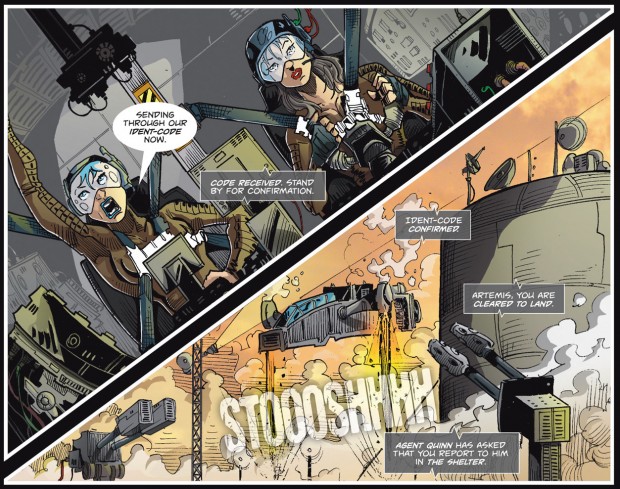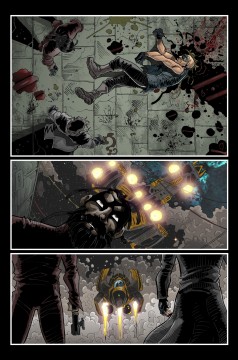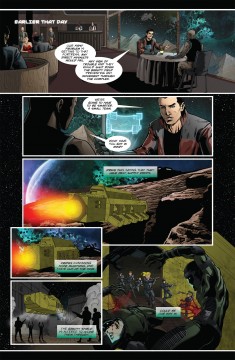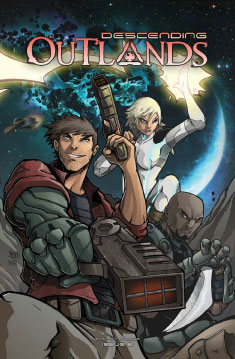“At a time when there was minimal space sci-fi around I wanted to create something that filled the void.” Shaun Dobie talks Descending Outlands
 With the second issue of his science fiction space opera Descending Outlands set to debut at this weekend’s Melksham Comic Convention 2015, we catch up with writer and colourist Shaun Dobie to discuss Star Wars, spaceships and filling the space sci-fi void.
With the second issue of his science fiction space opera Descending Outlands set to debut at this weekend’s Melksham Comic Convention 2015, we catch up with writer and colourist Shaun Dobie to discuss Star Wars, spaceships and filling the space sci-fi void.

Tell us about the back story for Descending Outlands? What would be your ‘elevator pitch’ be for new readers?
SD: What was supposed to be a simple heist gets complicated for Nate Avery and his crew of rogues in the space epic, especially when they find out the cargo they are stealing is not what it appears.
On the run from the corporate entity known as “The Fountain” who will stop at nothing to get their hands on it, and the arrival of a mysterious man with great power, the stakes have never been higher and so they are forced to hide out in a place that only thieves, opportunists and assassins dare to call home. The Outlands.
It reminded us a lot of Joss Whedon’s Firefly and of course Star Wars, what were the main inspirations you had for the series?
SD: I’ll start with Firefly/Serenity as off course that was an inspiration, its impossible to not draw comparisons against the first issue, and was an amazing piece of work that we all miss. I’ve always loved sci-fi and space travel. The vision of amazing technologies, fantastic ships, and the freedom of what can be done in that arena. More so though, i love the idea of us, now, being in that playground.

A lot of earlier sci-fi shows, such as Star Trek TNG, have humans in space surrounded by this wonder but they have all evolved with this technology and have a “futuristic” demeanor about them. What i love about the original Star Trek films, Stargate SG-1/Atlantis/Universe, Firefly, Farscape, and Star Wars (NOT PREQUELS!!!!), was the whole ‘yee-haa’ cowboys in space attitude. They portrayed the every-man that exists in our world, with our viewpoint and mannerisms, and put them in this futuristic fantastical world. Plus, who in this world has not wanted to be Han Solo, Jack O’Neill, or Malcolm Reynolds.
The original Star Wars trilogy was also a huge influence with regards to making sure that the ships, especially their ship the Everett Young, was gritty and rundown. Much like the Millennium Falcon, this is a ship of rogues, patched up with custom mods, minimal budgets and having to survive many a skirmish when things went bad.
At the end of the day, in a time when there was minimal space sci-fi around (Stargate, Star Wars, Firefly, Farscape and Star Trek had all finished), i wanted to create something that was just space fun to fill the void i felt.
You’ve worked with a variety of artists on the series, why is that? A style choice or a necessity?
SD: I am a writer and a colorist, but I cannot draw to save my life hence the need to hire artists. Over the years I have worked with many artists, but not all experiences were good. Regardless of intentions or quality, sometimes life just gets in the way and so pages get delayed or sometime never appear. I was, and still am, so passionate about Descending Outlands that I didn’t want the artists to be the bottle neck.

I wanted my story to be told.I decided early on that I wanted Descending Outlands to be more like a TV series. An overall season story arc, but split into individual episodes that could focus on specific points or characters. Much like how each TV episode can have a different director, my chapters have a different artist. Also physically splitting into chapters helps the mind deal when suddenly the artwork changes mid-story.
One of our favourite features in Descending Outlands is the quality of the presentation. Especially the design, lettering and colour work. how important was it for you and letterer Vince Hunt to put together a great looking package for the comic as well as making the pages look great?
SD: Not to undersell story, but I think presentation is one of the most important features in selling anything. Like it or not, we live in a fickle society and if someone doesn’t like the way something looks, then they normally don’t bother to even read the story to find out if it is good or not.
I’m as guilty as everyone else, being drawn to glossy cover art like a magpie, but then full of disappointment as I open it up to find the polar opposite inside.
I take pleasure in making sure that everything I create look as professional as possible. Also the more professional I can make it, the less likely people are to think its just a low budget small press comic. That then gives them confidence in it and helps persuade them to give it a try in the saturated market, bursting with variety and talent.
Has digital colouring improved or reduced the quality of small press comics?
SD: I think colour, if done right, can completely change a comic. Elevating it from the pages and allowing you to set tone, clarity and focus in ways that you cannot do with inks alone. Saying that, i have seen a lot of poor colour attempts, which i feel do the opposite. If you have a poor colourist then sometimes black and white art would probably have looked nicer.

Do you have any tips or words of wisdom for aspiring colourists and do you think the average reader notices and appreciates it?
SD: If there is anyone that wants to get into comic colouring, then my best advice would be to practice and don’t be afraid to use references. When you start, its hard to know how and where light falls on a face or object, as such find images to use as reference to show you.
Often i find myself doing silly things like shining a light on my face while looking in a mirror to see what it looks like from a specific angle….references are not cheating, so use them. Also after you have drawn light hitting a face for a while, it will then become instinct and you will not need references in future.
Also patience is key. Flatting and then shading a detailed sequential page can easily take a few hours, so be prepared for that.
My final advise to colourists is to experiment. You don’t have to make every coming photorealistic. Some of the best looking ones have a style all to themselves. Some stay with black and white, but use an extent colour such as blue or red to make panels pop, where as some stick to simplistic animation style cell shaded look. It all depends on the artwork, and style you want to give your comic.
With Descending Outlands I wanted to give it a gritty, realistic feel so there is lots of browns and rusty looking areas juxtaposed against beautiful scenic space scenes, whereas with The Red Mask From Mars, creator Vince Hunt wanted a more vibrant, simplistic, Sunday morning cartoon look to it.
Tell us how the book is available and where people can get it from – in particular how is it available digitally, why did you choose that outlet and does having it available digitally help spread the word to a larger audience?
SD: Both issues are available as print or digital download and is currently in the review process of Comixology. I have found that digital is good for reviewers mainly and that with small press people prefer to actually have a physical item. Most sales from from conventions themselves.
However, on the website is a free online version of Chapter 1, which people generally read and then decide to purchase the comic itself :
Find out more about Descending Outlands online at www.


